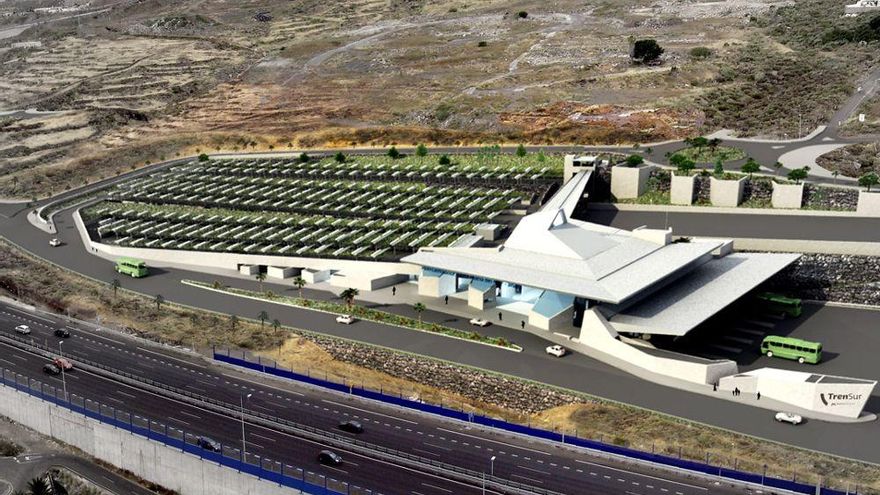A landmark agreement for Tenerife’s railways
In a historic move for Tenerife’s infrastructure, the Spanish government has signed the first protocol to guarantee co-funding for the island’s long-awaited North and South railway lines. The agreement, signed on Thursday, September 4th, between the State, the Canary Islands Government, and the Tenerife Council, establishes the first concrete roadmap for construction. This project is a direct response to the island’s urgent need for both short and long-term solutions to the severe congestion plaguing its main arteries, particularly the TF-1 Southern Highway and TF-5 Northern Highway.
First phase: the southern line from San Isidro to Adeje
The protocol confirms that construction will begin with the first phase of the Southern line, running between San Isidro and Costa Adeje. The current plan is for these initial works to go out to tender between late 2027 and early 2028. The state’s multi-year financial contribution will be formally secured through a further convention, to be signed once the Tenerife Council updates the project plans for both lines, which have become outdated with lapsed environmental impact declarations. This initial protocol specifically covers the Southern project, as it is the most advanced, though the island’s government is also working to include the Northern line in a future agreement.
A definitive state endorsement for island rail
The officials who signed the co-funding protocol at the Presidency of the Canary Islands Government headquarters in Santa Cruz de Tenerife hailed the step as “decisive” and “historic.” They emphasized that it represents a “definite endorsement” from the national government for integrating rail transport into the Archipelago’s network. Canarian Minister of Territorial Policy, Ángel Víctor Torres, stressed that the railway lines align with the state’s commitment to sustainable mobility, stating, “In a community with over two million inhabitants and 15 million tourists a year, it is necessary to reinforce public transport with a system, like rail, that consumes the least possible territory.”
Correcting a historical exclusion
Representing the Ministry of Transport, Secretary of State José Antonio Santano remarked that this protocol corrects the historical exclusion of the Canary Islands from the national railway network. “It is a historic milestone because the State is committing with this agreement to develop the railways of the Canary Islands,” Santano asserted. He clarified that the central government has already invested 50 million euros in configuring and updating the projects for Tenerife and Gran Canaria. He highlighted that the future trains will be “territorially structuring lines” that will “bring people closer to different municipalities and foster new economic opportunities.”
From a 1909 vision to a modern reality
The President of the Canaries, Fernando Clavijo, expressed that with this protocol, “the trains of the Canary Islands are closer than ever to becoming a reality.” He drew a parallel to the initial criticism of the Tenerife Tram, the first rail system implemented in the islands, which is now an indispensable part of metropolitan public transport. “It was a heavily criticized project, but in the end, reality prevailed—that is, the need to reinforce mobility with sustainable systems on an island, Tenerife, that is approaching one million inhabitants,” Clavijo stated. Minister Torres even read from the first official document that established the need for a train in Tenerife, dating back to September 15, 1909, and signed by the then civil governor.
Project details and timeline
Tenerife Council President, Rosa Dávila, detailed the status of both projects. The Southern line is being prioritized first due to demographic factors; it is the area with the fastest-growing population and the highest number of tourists by far. The Council is currently updating the construction projects and environmental impact statements for the different phases of the southern line. The most advanced phase, San Isidro-Adeje, which will cost approximately 950 million euros, is slated to be the first constructed. The intention is to put the works out to tender by early 2028 at the latest. The total cost for the complete Southern line is estimated at 2.5 billion euros.
Revolutionary travel times and a new airport stop
As Rosa Dávila highlighted at the signing, the new line will dramatically reduce journey times, allowing travel from Santa Cruz to Adeje in just 39 minutes. One reason for the project update delay was the decision to incorporate a stop at Tenerife South Airport. “We are working jointly with Aena, the airport manager, to adapt this stop to the renovation of the facility that is going to be undertaken,” Dávila specified. The Northern line, planned between Santa Cruz and Los Realejos with options for extension to Icod de los Vinos, will be developed in a second protocol and agreement with the State.

